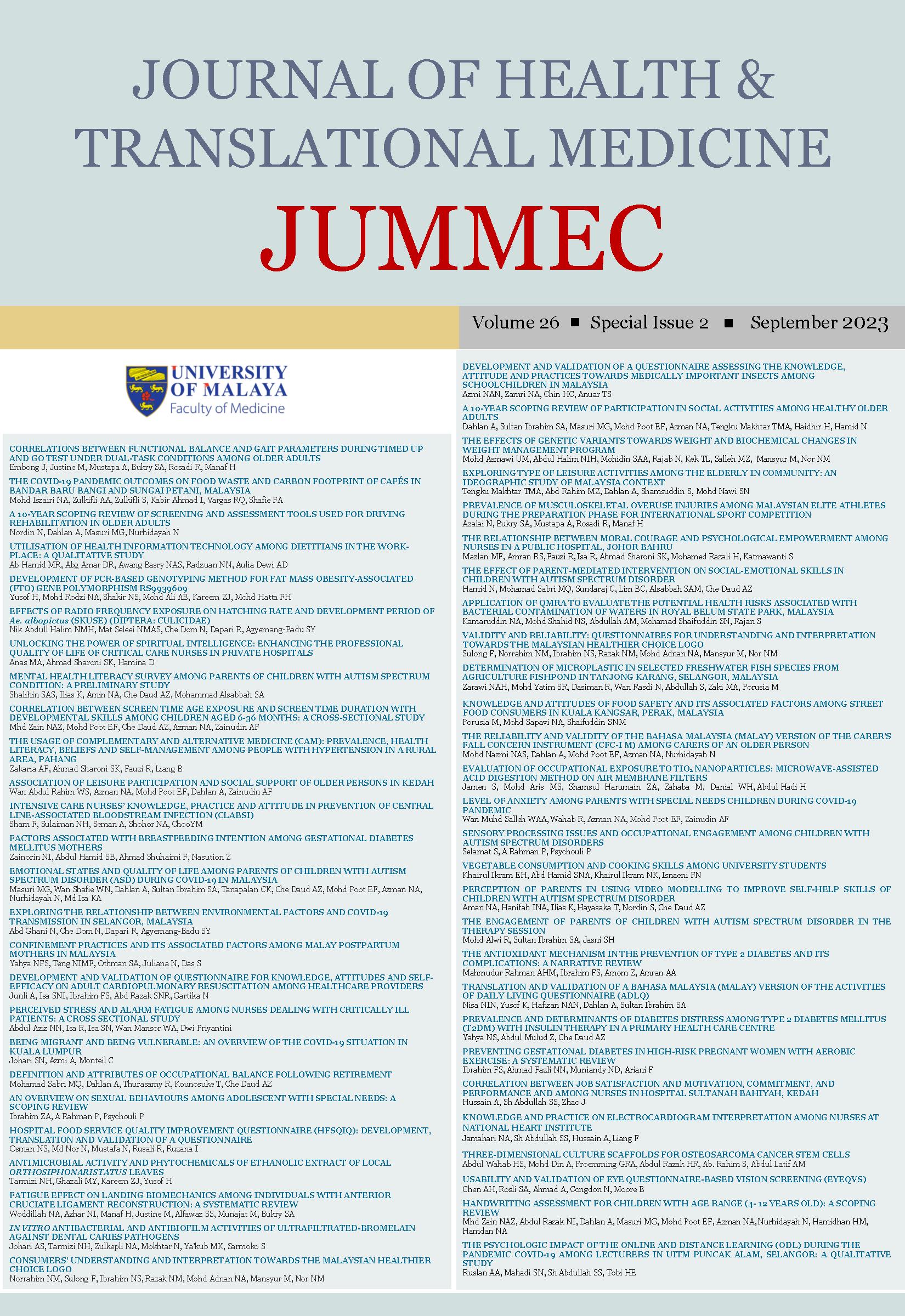THE USAGE OF COMPLEMENTARY AND ALTERNATIVE MEDICINE (CAM): PREVALENCE, HEALTH LITERACY, BELIEFS AND SELF-MANAGEMENT AMONG PEOPLE WITH HYPERTENSION IN A RURAL AREA, PAHANG
Received 2023-07-10; Accepted 2023-08-17; Published 2023-09-15
DOI:
https://doi.org/10.22452/jummec.sp2023no2.10Abstract
Complementary and Alternative Medicine (CAM) is believed to have had health benefits in treating hypertension in
past decades, especially in rural areas. However, CAM is often not supported by scientific evidence. Thus, awareness
of the possible toxicity of CAM in the self-management of health is crucial. This study aims to identify CAM users’
prevalence, beliefs, health literacy, and examine the associated factors for the self-management of hypertension.
This cross-sectional study used a set of questionnaires consisting of demographic data, health-related characteristics, the Montana State University CAM Health Literacy Scale, the Hypertension Self-Care Activity Level Effect (H-SCALE), and the Beliefs About Medicine Questionnaire (BMQ). The study employed simple random sampling, and it was conducted in four health clinics located in Jerantut, Pahang, from January 2021 to May 2021. The analysis involved a total of 233 hypertensive patients. The study found that 60.9% (n = 142) of the participants used CAM within the last 12 months to treat hypertension, with herbs (n = 71, 50%) being the most preferred alternative medication. Most of the respondents had adequate health literacy regarding CAM usage (mean 44.50 ± 5.67) and held a positive perception toward CAM with Specific-Necessity (mean 17.61 ± 2.91) higher than Specific-Concern (mean 15.02 ± 3.40). The results showed that 96.1% (n = 224) reported adherence to alcohol cessation, 65.7% (n = 153) reported adherence to taking medication, 62.7% (n = 146) reported adherence to quitting smoking, 39.9% (n = 93) reported adherence to good weight management, 25.3% (n = 59) reported adherence to active physical activity, and only 14.2% (n = 33) reported adherence to take a healthy diet. The results of multiple logistic regression analysis showed that the female gender was linked to non-adherence with taking medication while having higher health literacy was related to greater adherence to medication. The study also found that female gender was associated with non-adherence with quitting smoking, which was accompanied by a higher belief about medication specificnecessity. In contrast, older age was related to better adherence to quitting smoking. Factors such as being female, having longer disease duration, and having higher health literacy were associated with non-adherence with weight management, while having formal education and a stronger belief in the importance of specific medication were linked to greater adherence to weight management. The study found that a higher belief in the importance of specific medication and being female were related to non-adherence with quitting alcohol use. This study may provide a better understanding of CAM usage among people with hypertension with significant concerns over safety and interaction with the standards prescribed treatment. Further intervention is needed to decrease the possibility of complications and optimize self-management of hypertension with the use of CAM.
Downloads
Downloads
Published
Issue
Section
License
All authors agree that the article, if editorially accepted for publication, shall be licensed under the Creative Commons Attribution License 4.0 to allow others to freely access, copy and use research provided the author is correctly attributed, unless otherwise stated. All articles are available online without charge or other barriers to access. However, anyone wishing to reproduce large quantities of an article (250+) should inform the publisher. Any opinion expressed in the articles are those of the authors and do not reflect that of the University of Malaya, 50603 Kuala Lumpur, Malaysia.


